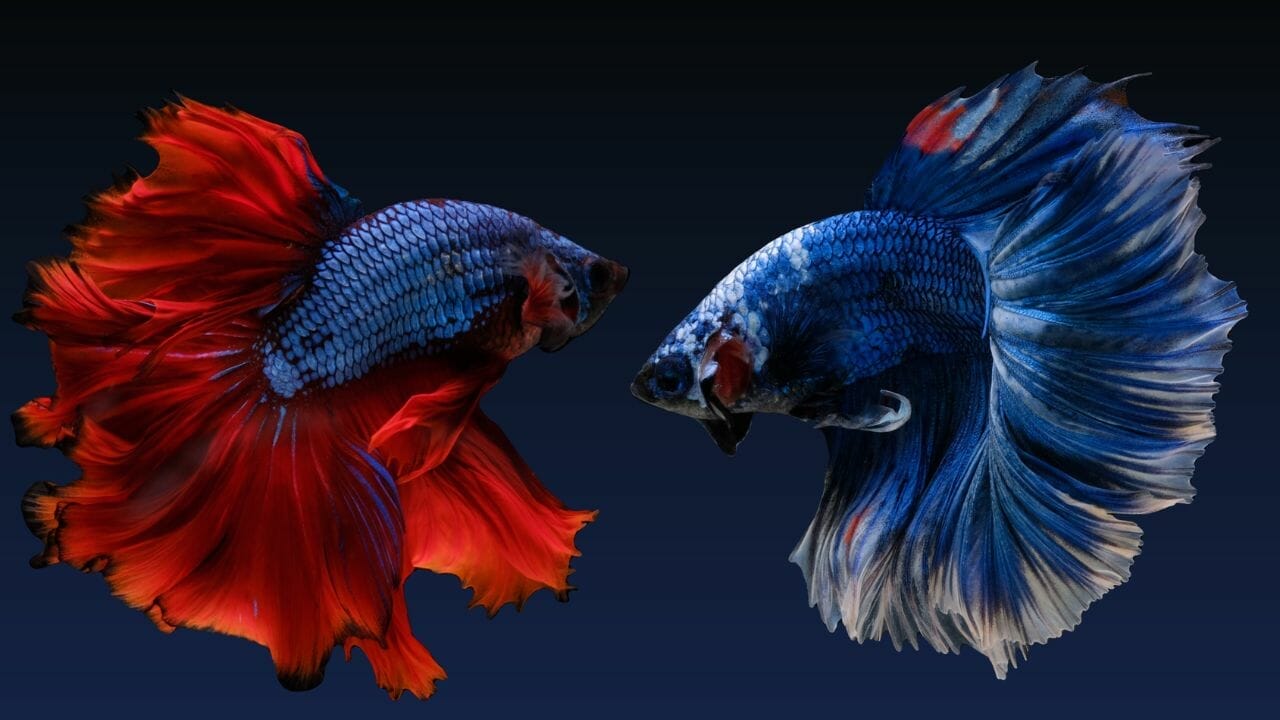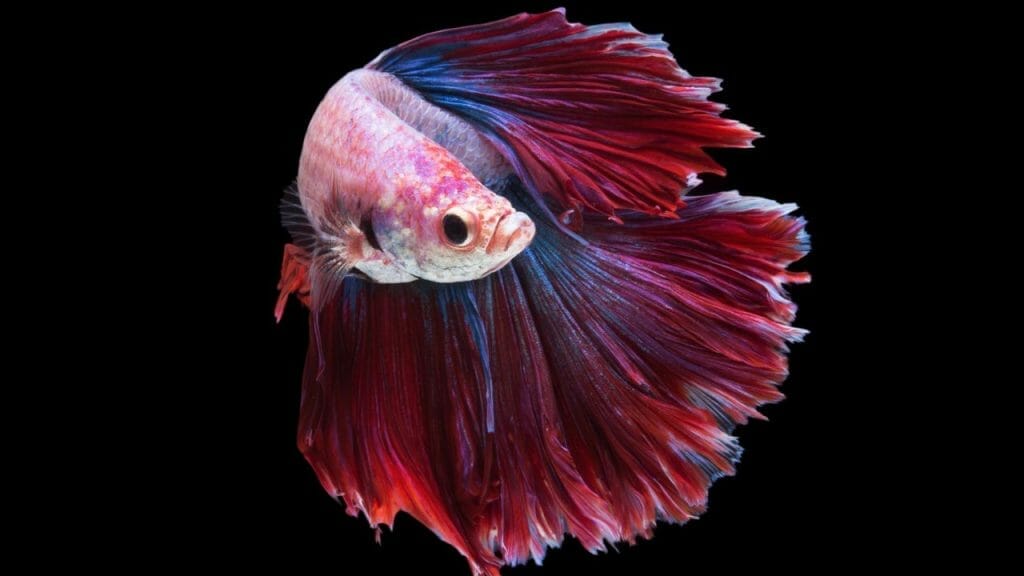Are Halfmoon Bettas Less Aggressive?

Halfmoon bettas are one of the prettiest tropical fish, but their pretty appearance does not really indicate whether they are less aggressive or not. Most betta owners get confused about the personality of the Halfmoon bettas. But before purchasing this betta breed you should have proper knowledge about their aggression.
The halfmoon betta is considered a very aggressive fish and territorial fish. They are very aggressive towards other fish that tries to invade their territory. Their aggression can take many forms, manifest in a variety of ways, and be caused by a variety of factors.
If you would like to learn more about the aggression of Halfmoon bettas, you can read the following article.
Why A Halfmoon Betta Fish Becomes Aggressive?
It is not surprising that Halfmoon betta fish are aggressive for many reasons. Siamese fighting fish are naturally aggressive so they become violent mainly to protect their territory, and food, maintain their dominance, for stress, tank environment and, to attract female halfmoon bettas. The major source of their aggressiveness is food and mating which is directed at females.
Here’s more detailed information in the later part of the article about the aggressiveness of Halfmoon betta:

1. Territorial Aggression
Halfmoon betta fish or Siamese betta fish has a reputation for territorial aggression. They mainly attack other fish for their provincial behavior. Halfmoon bettas claim the aquarium as their own home which makes them insecure and start fighting with other fish.
Male Halfmoon bettas cannot get along with other aquarium fish. They get triggered by other fish in the aquarium and attack their tank mates. They mostly prefer to stay alone. Male Halfmoon bettas feel threatened if they see any fish and become extremely aggressive to establish their position.
Female Halfmoon bettas can get social with some other fish but they become aggressive if there is less space in the aquarium. Female Halfmoon bettas act aggressively in a congested aquarium but can live together if kept with other fish in a large tank.
They start fighting with the fish that has bright colors and a large tail and fin. Halfmoon bettas naturally get triggered by the personality of their opponents.
In Southeast Asia, Halfmoon bettas are raised in a way that makes them aggressive and forced to fight with other fish. Thus, their fighting behavior is a reaction to how they are reared.
2. Aggression Towards Other Fish
As an owner of Halfmoon betta, you need to spot the signs of aggression in them. This pretty fish species like to stay in solitary. Halfmoon bettas cannot tolerate any other fish that comes inside their area so they display their aggression by trying to look larger through flaring gill, nipping of fin, ramming, etc.
They try to make themselves look large and strong in front of other fish. They also spread their fins to appear larger for frightening their opponent. If your Halfmoon betta starts flaring its fin, that means they are trying to attack other fish.
Halfmoon bettas start ramming their body together to hurt each other. They also nip the opponent’s fin and bite their chunks. Among all other signs of aggression, this is a sign of dangerous physical aggression. This bite leads to fatal injury.
3. The Tank Factors That Trigger Their Aggression
You must be careful about the number of tankmates in Halfmoon bettas aquarium and ensure at least 10 gallons of water with lots of plants.
If the aquarium has enough gallons of water and real or plastic plants then your Halfmoon betta will not become overly territorial. Female Halfmoon bettas can live comfortably with other fishes if the aquarium has enough space. Females get aggressive in congested places with lots of tankmates.
Male Halfmoon bettas are more likely to fight with other fish so they like to live solitarily. Two male bettas cannot be placed in the same tank because they will fight and even kill each other.
It is also better not to keep male and female Halfmoon betta fish together, except temporarily for breeding.
4. Other Reasons
Halfmoon bettas also act aggressively to defend their right to eat. If they feel exposed while feeding then they try to protect their meal from other fish. Male bettas also defend their bubble nest from others because they keep their eggs safely in their nest. Sometimes male bettas also get stressed and respond aggressively to their reflection if mirrors are placed inside the aquarium.
Sometimes their aggressive sign cannot be noticed. But you may see other signs which include behavior change, increased hiding or prolonged hiding period, torn fins, missing scales decreased appetite, etc. If you notice any of these signs in your Halfmoon betta that means they are fighting. You may also notice major or minor injuries which means probably they are fighting when you haven’t looked.

Which Fish Can Coexist With Halfmoon Bettas?
Male Halfmoon bettas can live peacefully with non-aggressive and plain light-colored fish because they will not trigger Halfmoon betta. Bright color and flowing fins and tails trigger Halfmoon bettas as they make them seem too much. So snails, shrimp, and cory fish can be safe tankmates for them.
Halfmoon bettas tankmates can be Kuhli Loaches, Harlequin Rasboras, Ember Tetras, female Cardinalfish, Pygmy, Malaysian Trumpet snails, female Gypsies, etc. These fish species are less aggressive and stay away from the places bettas roam in the tank. Their food habits and characteristics don’t bother Halfmoon bettas.
Smaller in size, less colorful, and decent fish species can be peaceful tankmates for your Halfmoon bettas. So Siamese fighting fish can live with fish if chosen wisely otherwise they will attack and get injured or die. If you see they are fighting then the aggressive one should be separated.
Final Verdict
So now we have a clear knowledge of whether Halfmoon bettas are aggressive or not. However, before buying Halfmoon bettas you should know more about their availability. Therefore, have a look at my next article to know more. Are Halfmoon Bettas Rare?
About Author
Hello, I’m Muntaseer Rahman, the owner of AcuarioPets.com. I’m passionate about aquarium pets like shrimps, snails, crabs, and crayfish. I’ve created this website to share my expertise and help you provide better care for these amazing pets.
Disclaimer
This site is owned and operated by Muntaseer Rahman. AcuarioPets.com is a participant in the Amazon Services LLC Associates Program, an affiliate advertising program designed to provide a means for sites to earn advertising fees by advertising and linking to Amazon.com. This site also participates in other affiliate programs and is compensated for referring traffic and business to these companies.

